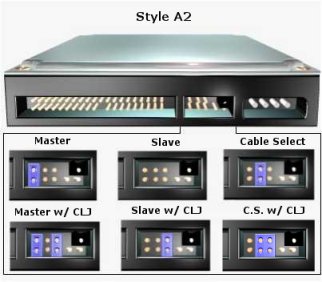
Master, Slave, or Cable Select - Which jumper settings should I use?
Master/Slave
Under most conditions the standard Master or Slave setting should work just fine. Seagate and Maxtor ATA drives ship directly from the factory configured as a Master device. If the drive is going to be installed as the only device on the ribbon cable, or is going to be installed as the boot drive, then the default Master setting can probably be used without any problems. Just keep in mind that the Master device should always be attached to the end (black) connector on the Ultra ATA (UDMA) ribbon cable (this cable is supplied with your retail box).
If the drive is going to be installed as a secondary device to another hard drive, then use the Slave setting outlined in the jumper diagram. A Slave device should always be attached to the middle (gray) connector on the ribbon cable.
Note: Hard drives should never be configured as a Slave device to a CD-ROM or DVD drive.
Cable Select
Cable Select (CS) is an alternative - plug and play - method for configuring ATA or ATAPI devices. In this configuration both the master and slave drives utilize the same jumper configuration (that is, both devices are set to Cable Select). The drive's master or slave status will be determined by which connector the drive is attached to on the cable (black connector for master, gray connector for slave). Many ATAPI devices such as CD-ROM and DVD drives, or ATA hard drives from other manufacturers, may come pre-configured as Cable Select. This option should be taken into consideration when installing a new ATA drive with any existing ATAPI or ATA devices that may employ Cable Select as their default setting.
Note: To use this option you must use the Ultra ATA ribbon cable supplied in your retail box.
Seagate recommends that you use the Auto-Detect Feature in the BIOS for hard drive configuration.
If your BIOS does not utilize Auto-Detect, Seagate recommends that you:
- Manually enter the Maximum Cylinder value for the hard drive if greater than 8.4 GB.
- Manually enter the Actual Cylinder value for the hard drive if less than 8.4 GB.
| Model | ACTUAL CYL | MAX CYL | HDS | SECT | GB CAPACITY |
| 6B160P0 | 317,632 | 16,383 | 16 | 63 | 160GB |
| 6B200P0 / 6B200R0 | 395,136 | 16,383 | 16 | 63 | 200GB |
| 6B250R0 | 486,344 | 16,383 | 16 | 63 | 250GB |
| 6B300R0 | 588,422 | 16,383 | 16 | 63 | 300GB |
"P" denotes ATA/133 with 8 MB Buffer, "R" denotes ATA/133 with 16 MB buffer
NEVER enter more than 16,383 cylinders in the system BIOS.
This may potentially cause data loss.
See here for information regarding Binary and Decimal calculations.
Cable Requirements: An 80-Wire UDMA Interface Cable is REQUIRED for all UDMA/66/100 hard drives. It is recommended for all UDMA/33 hard drives.
 Model Number Naming Conventions have changed with the release of the DiamondMax Plus 60 series. This numbering convention remained in existence for all Maxtor-brand drives before the Seagate merger. For example, the Model Number 5T060H6 is a 60-gigabyte hard drive.
Model Number Naming Conventions have changed with the release of the DiamondMax Plus 60 series. This numbering convention remained in existence for all Maxtor-brand drives before the Seagate merger. For example, the Model Number 5T060H6 is a 60-gigabyte hard drive.
*GB = 1 billion bytes. Total accessible capacity varies depending on operating environment.





